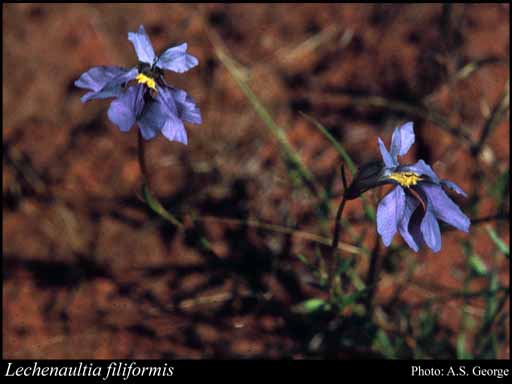- Reference
- Prodr. 581 (1810)
- Conservation Code
- Not threatened
- Naturalised Status
- Native to Western Australia
- Name Status
- Current
Grass-like, ascending annual, herb, 0.1-0.45 m high. Fl. blue, Jan to Jul. Sandy soils, stony loam. Sandstone rocks, flats, along creeks.

Scientific Description
Stems unribbed. Leaves flat, 9-20 mm long, 0.4-0.7 mm wide, Indumentum absent (leaves glabrous); margins entire. Bracteoles absent. Pedicel pedicellate, Pedicel length the pedicels 30-38 mm long, glabrous. Calyx lobes present, Calyx length 4-9 mm long, hairy, with sparse, absent hairs. Corolla blue or mauve, 16-20 mm long, without auricles, not spurred, glabrous on the outside, glabrous on the inside; central lobes 5.2-9 mm long, with wings; outer lobes 9-10 mm long, wing present on both sides and clearly unequal, 1-3 mm wide on the narrower side, 1.2-3.5 mm wide on the broader side. Anthers free. Ovary inferior, not gibbose; style 8-10 mm long, hairy; indusium single, hairy; ovules more than two. Flowers in January, February, March, April, May, June and July. Occurs in the Northern Kimberly (NK) and Central Kimberly (CK) IBRA Region(s), of the Northern (N) Botanical Province.
Distribution
- IBRA Regions
- Central Kimberley, Northern Kimberley, Ord Victoria Plain.
- IBRA Subregions
- Berkeley, Mitchell, Pentecost, Purnululu.
- Local Government Areas (LGAs)
- Derby-West Kimberley, Wyndham-East Kimberley.